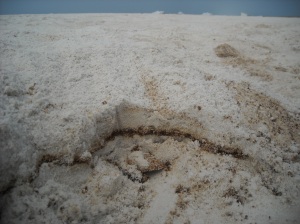Went out to Santa Rosa Island on the sky trail of the Blue Angels. The local press and powers were all about encouraging everyone to come out to the beach.It had been over a month. I thought I’d never go back because of the pain and the worry about exposure. Having just lost my sister, more loss is hard to bear.
Looking out over the water it was hard to see oil in the waves. But the trucks and hundreds of workers dressed in hazmat boots and jackets combed over the beach with shovels, skimmers, and plastic bags. It took only a few minutes to see what they were working on: oil beneath the sand.





These photos were taken on July 11, 2010. All along the beach road were trucks and down just about every entrance to the beach there were volunteers digging in the sand and bagging oil laden sand and seaweed.
The air stank with petroleum, breaking down in the intense heat and sunlight. I felt nauseated and weak and had to leave after only 15 minutes.
I noticed a few dolphins fishing close to shore and a couple of small dolphins in the bay adjacent to the Santa Rosa bridge when I drove over to the beach. On the shore, I saw no sandlerlings or gulls actually standing or running along it. A pair of willets stood in the dry sand above the shoreline. They did not seem skiddish at all, allowing me to approach closely for a photo. I thought that unusual behavior. As I left at the Ft. Pickens entrance parking lot, about thirty gulls congregated atop the restroom pavilion and were loudly squawking from their rooftop perch.
One man swam in the waves and out in the open water was a huge ship of some kind, perhaps skimming oil, or maybe doing some kind of research – it was an industrial looking type ship with a flat deck, quite high out of the water.
Our beach is greatly impacted. Don’t be fooled by the hype for tourism. We need to be more responsible about attracting unwary citizens and visitors to our shores, even if it means we’ll be hurt economically. It is the right thing to do to be honest, transparent, and to recognize and act like our home is under assault from our own energy policy and our corporate practice of taking risks with the public’s health and the environment’s well-functioning.






